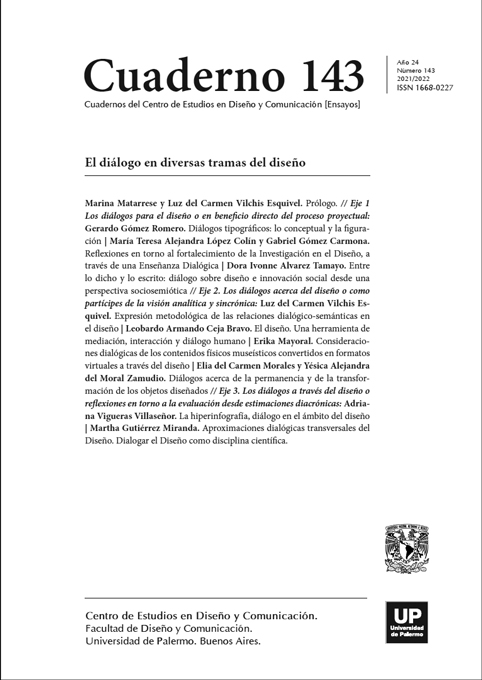Consideraciones dialógicas de los contenidos físicos museísticos convertidos en formatos virtuales a través del diseño
Abstract
Today museum’s exhibitions provide stories with a beginning, a development to reach an end, this facilitates the understanding of a narrative that was previously delimited to have a solid curatorial argument. Both the reading and the thematic content of the museums are possible aspects to be perceived in the exhibition’s discourses presented with routes that include multiple objects together with analog and digital audiovisual supports. Through a great museological work, these enclosures enable spaces for their visitors to experience in different ways the story they wish to give and one of their great allies has been design by synthesizing stories and information in an effective way with time lines for example. Such dialogic relationship has had to be expanded to create virtual museums and exhibitions so by clicking on a computer or cell phone it is possible to take a tour of national and international exhibitions. This has given immense challenges for the physical museum’s stories could set down on web pages with attractive designs and digital supports that have evolved along with technology itself.
References
Bonet, E. (2002). La instalación como hipermedio. En Gianetti, C. Media Culture. Barcelona: L’Angelot: 95
DigitalCamera.es (2017). Matterport Pro2 3D: las mejores visitas virtuales.Recuperado el 20 de Marzo 2021 de http://www.digitalcamera.es/novedades/matterport-pro2-3d/
Duarte. M. (2016). Públicos y Redes sociales. En Pérez Castellanos, L. (coord.) Estudios sobre públicos y museos, Vol I, Publicaciones Digitales ENCRYM-INAH, México: 216-220
Gianetti, C. (2002). Estética digital. Sintopía del arte, la ciencia y la tecnología. Barcelona: L’Angelot: 114
Giannini, T. & Bowen J. (2014). Museums and Digital Culture New Perspectives and Research. New York: Springer.
Helling, Stefan. (s.f.) Statistcs Strip. Recuperado el 13 de Marzo 2021 de http://stefanhelling.com/projects/statistics-strip
Hoffman D. & Novak T. (1996). Marketing in Hypermedia Computer-Mediated Environments: Conceptual Foundations. Journal of Marketing (3): 50-68. International Council of Museums (ICOM) (s.f.). Recuperado el 19 de Febrero 2021 de https://icom.museum/en/resources/standards-guidelines/museum-definition/
Marinetti, F. (2002). El Cine Futurista. En Packer. R. & Jordan, K. Multimedia. From Wagner to virtual reality. New York: Norton
Mateos, S. (2011). ¿Sólo informar o también persuadir? Museos y publicidad en España: Pensar la Publicidad, 1 (5): 203-205
Museo del Prado. (s.f.). La línea de tiempo del Prado: una visita contextual, histórica e interdisciplinar de la colección del Prado. Recuperado el 22 de Marzo 2021 de https://www.museodelprado.es/grafo-de-conocimiento/linea-de-tiempo
Ochoa, H. (2009). El carácter dialógico de la hermenéutica de Schleiermacher. Su fundamento y sentido. Instituto de Filosofía Pontificia Universidad Católica de Valparaíso. Recuperado el 4 de Febrero 2021 de http://www.scielo.org.co/pdf/ef/n39/n39a05.pdf
Oklahoma Museums Association (OMA) (s.f.). Recuperado el 19 de Febrero 2021 de https://www.okmuseums.org/resources/starting-a-museum/
Pontis, S. (2007). La historia de la esquemática en la visualización de datos. Recuperado el 4 de Marzo 2021 de https://www.academia.edu/9550451/La_historia_de_la_esquem%C3%A1tica_en_la_visualizaci%C3%B3n_de_datos
Ramírez, S. (2016). Cédulas y Textos. En Pérez Castellanos, L. (coord.) Estudios sobre públicos y museos, Vol I, Publicaciones Digitales ENCRYM-INAH, México: 132-133
Real Academia Española (RAE). (2020). Diccionario de la lengua española. Recuperado el 17 de Febrero 2021 de https://dle.rae.es/museo?m=form
Los autores/as que publiquen en esta revista ceden los derechos de autor y de publicación a "Cuadernos del Centro de Estudios de Diseño y Comunicación", Aceptando el registro de su trabajo bajo una licencia de atribución de Creative Commons, que permite a terceros utilizar lo publicado siempre que de el crédito pertinente a los autores y a esta revista.


